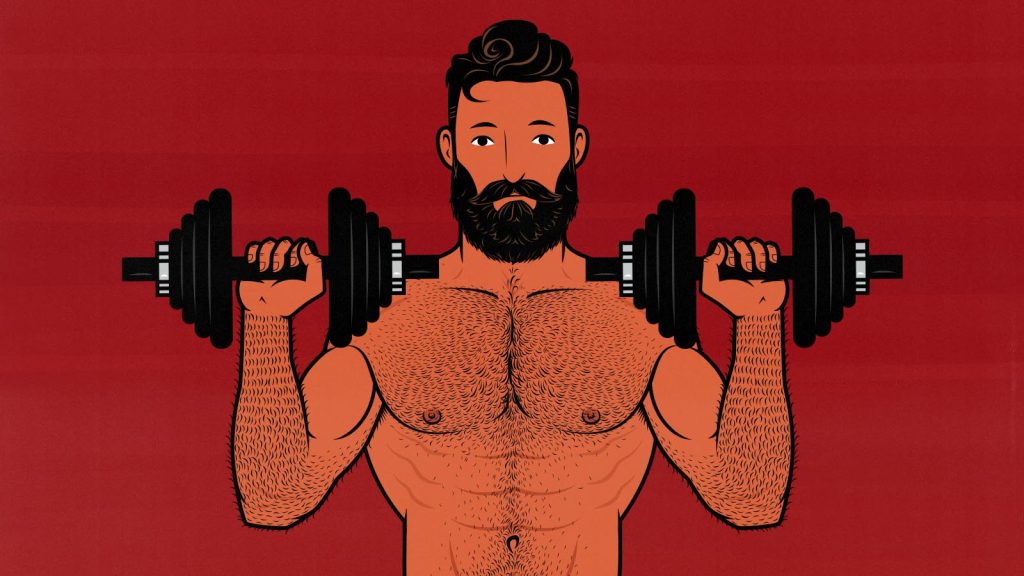
The Best Dumbbell Exercises for Every Muscle
You can build an entire workout routine out of just dumbbell exercises. There’s no real disadvantage to it, either. Dumbbell exercises are almost always just as effective as barbell, cable, and machine exercises. Often, the dumbbell variation is the best.
I broke down the exercises by body part, giving you the best dumbbell exercises for each muscle group. A fully balanced workout routine would have 1–2 exercises from each category, with those exercises spread out over two, three, or four workout days. If you’re new to lifting weights, I recommend starting with a 2–3 day full-body workout routine.
We’ve got a tutorial for every single exercise. Marco does most of them. He’s a strength coach with over 15 years of experience training college, professional, and Olympic athletes. I made a few tutorial videos, too.
Overview
You can break your body down into a few different muscle groups, each responsible for a different movement pattern. Your chest, front delts, side delts, and triceps are pressing muscles. Your back and biceps are pulling muscles. Your glutes and hamstrings extend your hips. Your quads open your legs.
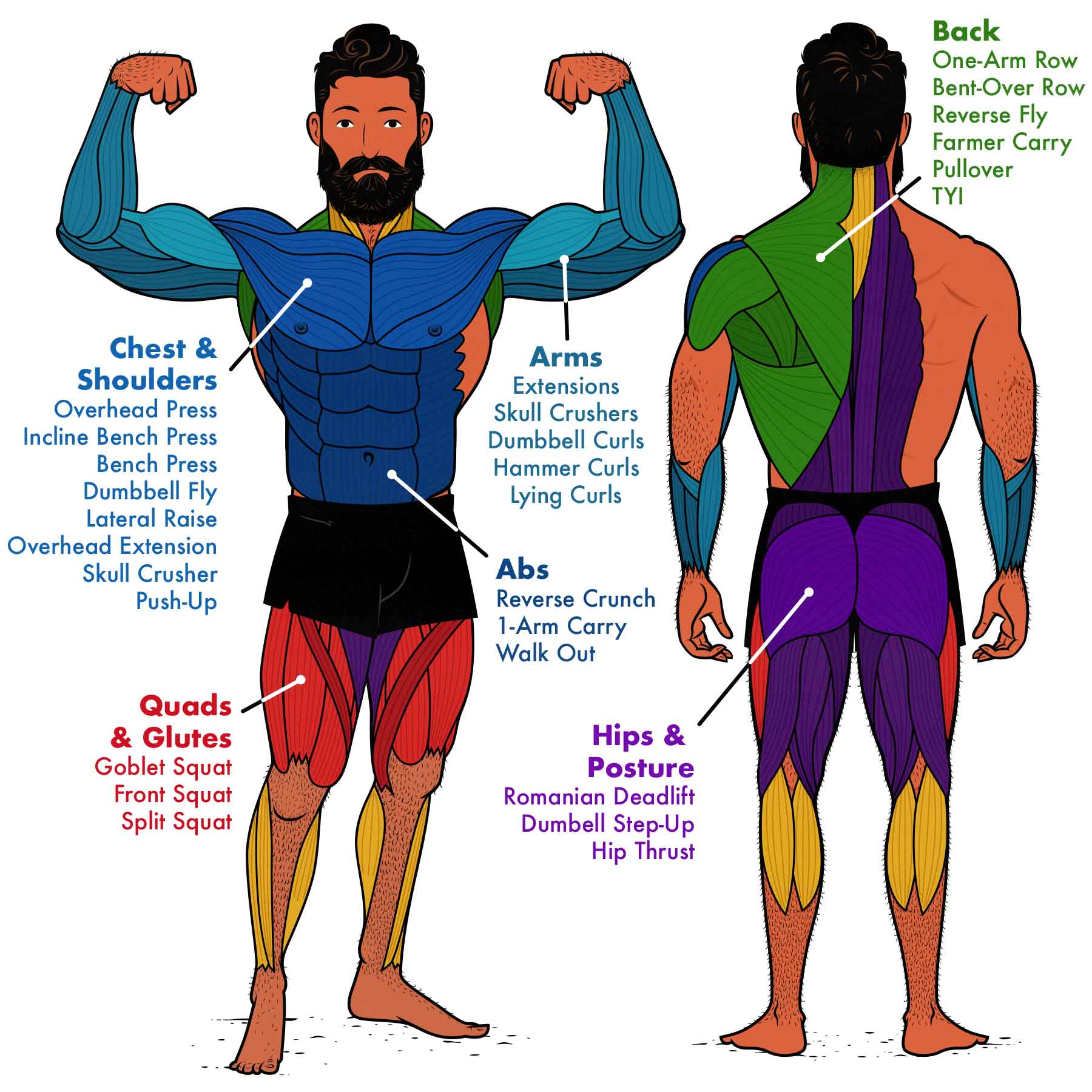
It’s usually wise to start your workout with exercises like goblet squats, dumbbell Romanian deadlifts, dumbbell bench presses, and dumbbell rows. That will work all the biggest muscles in your body, and it will do a decent job of stimulating the smaller ones. Then you can move to smaller exercises like dumbbell curls, triceps extensions, and lateral raises.
Quad Exercises
The best way to train your quads is with squat variations, so the best dumbbell exercises for your quads are exercises like goblet squats and split squats. Both of them work your quads, adductors, glutes, and postural muscles.
If you want to build a balanced and athletic lower body, it usually pays to do both goblet squats and split squats. You can do goblet squats one workout and split squats the next. If you just want to build muscle, it’s okay to pick between them.
Dumbbell Goblet Squat
Dumbbell goblet squats are arguably the best overall dumbbell exercise, especially for beginners. They’re a squat variation, so they work your quads, adductors, and glutes (but not your hamstrings).
They also do a great job of working the postural muscles in your back, the serratus muscles underneath your armpits, and some of the muscles in your arms and shoulders. They’re a full-body exercise.
The downside is that as you get stronger, it gets harder to challenge your lower body. If your dumbbells only go up to 50 or 100 pounds, you’ll eventually get to the point where you can do 12+ reps before hitting failure. At that point, you can switch to dumbbell front squats.
Dumbbell Front Squat
Dumbbell front squats are the same as goblet squats, it’s just that you hold two dumbbells instead of one, allowing you to lift up to twice as much weight. They work all the same muscles, but they’re a little easier on your arms. You can progress to these when you grow too strong for goblet squats.
The downside to dumbbell front squats is that if your dumbbells aren’t very heavy, you might still grow strong for them. At that point, you might need to train one leg at a time, doing split squat variations.
Dumbbell Split Squat
The dumbbell split squat is great for building muscle, improving your athleticism, and strengthening the muscles in your groin. They’re also great for working the most elusive head of your quads: the rectus femoris.
The rectus femoris crosses both the hip and knee joints, and it doesn’t activate very well during goblet squats. Bodybuilders solve that by doing leg extensions, but we need a dumbbell exercise. Split squats stretch out the rectus femoris of your back leg at both the hips and knees, giving you a nice weighted stretch at the bottom of the range of motion.
Hamstring Exercises
There aren’t very many dumbbell exercises that train your hamstrings. Fortunately, dumbbell Romanian deadlifts give you everything you need.
Dumbbell Romanian Deadlift
Dumbbell Romanian deadlifts work your hamstrings under a deep stretch at both the hip and knee joints. They’ll also bulk up your glutes, lower back, upper back, and forearms. They’re fantastic for building muscle.
The problem with dumbbell Romanian deadlifts is that you may soon grow too strong for them, especially if your dumbbells aren’t very heavy. At that point, you can shift one leg back, using it for balance, working just the front leg. That’s called a kickstand Romanian deadlift. You could also switch to step-ups, which we’ll cover in a moment.
Glute Exercises
The best dumbbell exercises for your glutes are goblet squats, dumbbell Romanian deadlifts, step-ups, and hip thrusts. All of them work your hips through a deep range of motion, and all of them seem to stimulate a similar amount of muscle growth (study).
If you want balanced muscle growth, I recommend doing goblet squats, dumbbell Romanian deadlifts, and step-ups. That’s almost always enough. But if you want extra thick glutes, you can add extra sets of hip thrusts.
Dumbbell Step-Ups
Dumbbell step-ups are surprisingly similar to deadlifts, it’s just that you’re working one leg at a time. If you get a nice stretch on your glutes at the bottom, and if you don’t use too much momentum, then they can be a fantastic glute builder.
Hip Thrusts
Hip thrusts were invented by Dr. Bret Contreras, and they’ve been mired in controversy from the beginning. But this article isn’t about that. Hip thrusts succeed at working your hips through a deep range of motion, and they also do a pretty good job of isolating your glutes, allowing you to bring them close to failure.
The downside of hip thrusts is that they aren’t very challenging at the bottom of the range of motion, which is where most of the muscle growth is stimulated. But if you’re using these as a finisher exercise after your squat and deadlift variations, that isn’t a problem.
Back Exercises
There are quite a few muscles in your back, and almost all of them have overlapping functions (full explanation). To train all of them, you want a combination of horizontal pulling exercises (like dumbbell rows) and vertical pulling exercises (like dumbbell pullovers).
You also want exercises using a narrower grip (like dumbbell rows) and flared elbows (like reverse flyes). Finally, you want exercises that work your spinal erectors, such as bent-over rows and dumbbell Romanian deadlifts.
One-Arm Dumbbell Row
The one-arm dumbbell row is the classic dumbbell back exercise. It’s the heart of your back routine. It’s especially good for your rear delts, rotator cuff, and lats. The only downside is that it doesn’t work your spinal erectors. We can fix that with the next exercise.
Bent-Over Dumbbell Row
The bent-over dumbbell row is similar to a one-arm dumbbell row, but you have to support the weight with your spinal erectors. This makes bent-over rows especially good for building a thicker back. If I had to pick, I’d say this was the best overall dumbbell exercise for your back.
Dumbbell Pullover
The dumbbell pullover is special because it stretches out the muscles in your upper back, working them hard at long muscle lengths. It’s another one of those controversial lifts. It’s unclear whether it does a very good job of working your lats. It does work the muscle underneath your lats—your teres major—quite well, though.
If you have a pull-up bar, you can do pull-ups or chin-ups instead. If all you have is a dumbbell, it pays to include some pullovers in your routine. It’s the only dumbbell back exercise that gets your arms overhead.
Dumbbell Farmer Carries
Dumbbell farmer carries train your upper traps and postural muscles. Some bodybuilders prefer dumbbell shrugs. That’s perfectly fine, especially if you’re training in a small space that doesn’t give you much room to pace around.
Chest Exercises
The best dumbbell chest exercises are dumbbell bench presses, dumbbell flyes, and deficit push-ups. I realize push-ups aren’t usually a dumbbell exercise. However, if you grip the dumbbells in your hands, you can sink between them at the bottom of every rep, getting a deeper stretcher on your chest and stimulating more muscle growth.
Dumbbell Bench Press
The dumbbell bench press is perhaps the best chest exercise of all time. It works your chest through a deeper range of motion than the barbell bench press, and it puts more emphasis on your chest muscles.
The downside is that it doesn’t work your triceps as well as dips, barbell bench presses, and push-ups, but we can make up for that with triceps extensions. More on that later.
Dumbbell Incline Bench Press
The dumbbell incline bench press is the best dumbbell exercise for your upper chest (and front delts). The incline position lines up better with your upper chest fibres. It isn’t a mandatory exercise, but if you have an incline bench, you can do a mix of flat and incline bench presses.
The downside of the incline bench press is that it doesn’t work your mid and lower chest very well. Those are the biggest muscles in your chest. That’s why the dumbbell bench press, push-up, and chest fly are so important.
Dumbbell Chest Fly
The dumbbell chest fly has a rocky history. It was beloved by classic bodybuilders (including famous ones like Arnold Schwarzenegger) but fell out of favour when bodybuilders started using cables to keep constant tension on their muscles.
However, modern research has been showing that challenging your muscles through a deep range of motion is more important, and that’s what the dumbbell fly is best at (meta-analysis). It’s back to being the king of chest isolation exercises.
Shoulder Exercises
Your shoulders have three heads: the front delts, side delts, and rear delts. You can train your front delts with pushing exercises (like bench presses and overhead presses) and your rear delts with pulling exercises (like rows and TYIs). That leaves your side delts, which you can train with dumbbell lateral raises and dumbbell upright rows.
Dumbbell Overhead Press
The dumbbell overhead press is the best dumbbell shoulder exercise. It does an especially good job of working your front delts, but it’s also good for your side delts, upper traps, and postural muscles. You could make a strong argument for it being one of the best dumbbell exercises overall.
The downside of the dumbbell overhead press is that it demands quite a bit of shoulder mobility. Some beginners can’t lift their arms all the way overhead like that. In that case, you can start by doing the half-kneeling version.
Half-Kneeling Overhead Press
The half-kneeling overhead press works your front delts, side delts, and upper traps just as hard as a regular overhead press. The advantage is that it also strengthens your posture, improves your shoulder mobility, and builds the strength you need to press dumbbells overhead.
Lateral Raise
The lateral raise is the best dumbbell exercise for your side delts. It’s simple, easy, and works very well, especially for beginners. The downside is that it’s hardest at the very top of the range of motion, which isn’t quite ideal for stimulating muscle growth.
Lying Lateral Raises
The lying dumbbell lateral raise works your side delts harder at longer muscle lengths. That makes it at least a little bit better for stimulating muscle growth. The downside is that it’s harder to set up and forces you to train one arm at a time. It’s magic for stubborn shoulders, though.
Reverse Fly
The reverse fly is a simple dumbbell exercise for your rear delts. They also do a good job of working your upper back muscles, including your mid and lower traps.
Dumbbell TYIs
Dumbbell TYIs are a more athletic version of the rear delt fly. The idea is to vary the movement pattern so that you hit more of the muscles in your upper back. Marco learned this one while studying under Eric Cressey, the head strength coach for the New York Yankees. He was using it to improve the shoulder strength of professional baseball pitchers.
Biceps Exercises
Dumbbells are perfect for building bigger arms. The best dumbbell biceps exercises are dumbbell curls and lying biceps curls, but it also helps to include pulling exercises like rows and pull-ups (if you have a pull-up bar).
Dumbbell Curls
Dumbbell curls are the most classic of all biceps exercises. They’re a complete biceps exercise, working both the short head and the long head. They aren’t particularly good at anything, but there’s also no real downside. It’s a solid exercise.
Lying Dumbbell Curls
Lying dumbbell curls are a more advanced variation of regular dumbbell curls. The first benefit is that it flips the strength curve sideways, working your biceps harder at the bottom of the range of motion. The second benefit is that it stretches the long head of your biceps at the shoulder joint, working it at longer muscle lengths. It’s a fearsome exercise. I highly recommend it.
Hammer Curls
Dumbbell hammer curls put your brachialis (the muscle underneath your biceps) in a better position to curl the weight up. When you bulk up your brachialis, it pushes your biceps further out, giving you bigger, wider arms. Hammer curls also do a reasonably good job of working your biceps.
Triceps Exercises
The best dumbbell triceps exercises are overhead extensions and dumbbell skull crushers. Both of these exercises work your triceps through a deep range of motion, and both of them put a good stretch on the long head. It also helps to do pressing exercises like push-ups.
Overhead Extensions
The overhead triceps extension is the best overall triceps exercise. Raising your arms overhead stretches out the long head at the shoulder joint, stimulating more muscle growth. The downside is that it demands quite a lot of shoulder mobility. Not everyone can do them properly.
Dumbbell Skull Crusher
The dumbbell skull crusher works your triceps through almost as deep of a range of motion as the overhead extension. The advantage is that you get to train both arms at once, the strength transfers beautifully to pressing exercises, and it doesn’t demand as much shoulder mobility.
Ab Exercises
To build balanced ab muscles, you need a mix of lower ab exercises (like reverse crunches), upper ab exercises (like hand walkouts), and oblique exercises (like 1-arm farmer carries). Your core muscles will also grow from goblet squats, dumbbell Romanian deadlifts, bent-over rows, push-ups, and dumbbell overhead presses.
Once you build abs you’re happy with, you can drop the isolation exercises from your routine, maintaining them with compound exercises.
Dumbbell Reverse Crunch
The dumbbell reverse crunch is the best dumbbell exercise for your lower abs. The dumbbell serves as a counterweight while you crunch your lower body up. It’s a great exercise for improving your posture, too.
Hand Walkout
The hand walkout is a bodyweight exercise, not a dumbbell exercise, but it’s important. You walk your way out, moving through the shoulder joint, stretching out your upper abs under load. It’s great for your upper abs, your posture, and your shoulder mobility.
1-Arm Farmer Carry
The 1-arm farmer carry is the best dumbbell oblique exercise. It’s also great for your posture, strengthening your grip, and bulking up your upper traps. It’s a criminally underrated beginner exercise.
Full Workout Program
If you want a full dumbbell workout program, check out our Bony to Beastly Program. You can do the entire thing with a pair of dumbbells. Even better if you get adjustable dumbbells that let you gradually increase the load as you grow stronger.
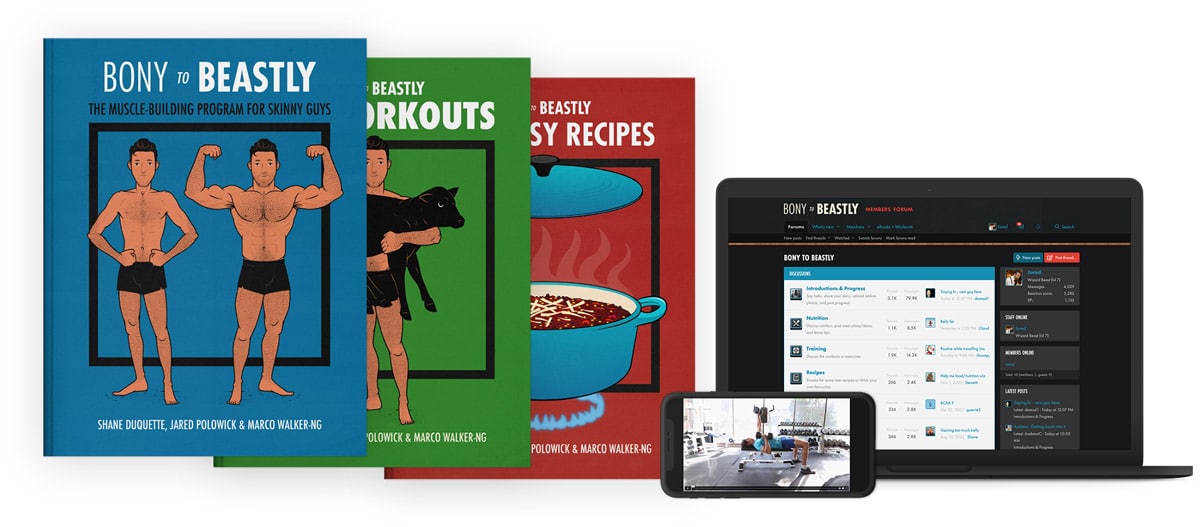
The program includes a 5-month workout program, a nutrition guide, a recipe book, tutorial videos for every exercise, and one-on-one support from us in our online coaching community. We’ll walk you through the entire process of gaining 20 pounds of muscle.



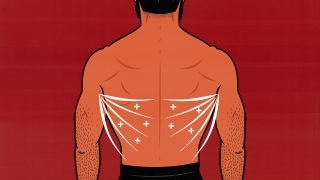
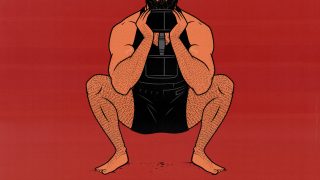
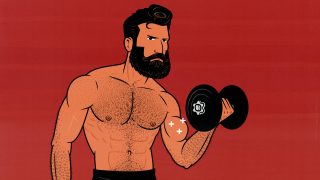
Hi Shane. I know this article is about dumbbell exercises, but for Abs these exercises seem quite weak. Which is the best overall ab isolation exercise?
I hear you. If you want an ab isolation exercise for building bigger 6-pack muscles, you could do a myotatic crunch, starting with bodyweight and then weighting it with a dumbbell.
If you don’t have a Bosu ball, you can use a pillow. You just need something under your lower back that will let you stretch your abs at the bottom of the range of motion.
Similar idea to doing cable crunches in the gym.
What about hanging leg raises? Are they effective? I have a pull up bar already that i use to perform chin-ups. I don’t perform any ab isolation exercises at all currently.
Yep! Hanging leg raises are great. Just make sure that you’re crunching your abs as you lift your legs up, not just moving at the hips.